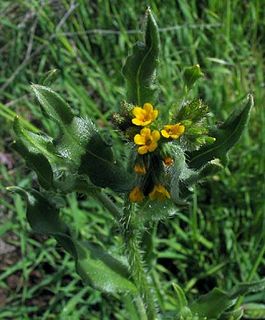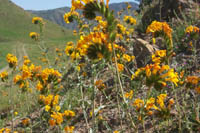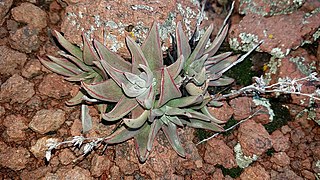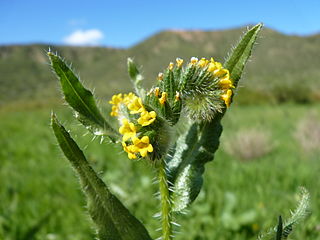
Amsinckia is a genus of flowering plants commonly known as fiddlenecks. The common name is derived from the flower stems, which curl over at the top in a manner reminiscent of the head of a fiddle. Fiddlenecks are in the family Boraginaceae, along with borage and forget-me-nots. The genus is named after the patrician Amsinck family in honour of the Hamburg head of state and patron of botany Wilhelm Amsinck (1752–1831).
Anguina amsinckiae is a plant pathogenic nematode, which attacks the weed called fiddleneck.

Amsinckia grandiflora is a species of fiddleneck known by the common name large-flowered fiddleneck. This is a wildflower endemic to California and considered a Critically endangered species on the state and national level.

The Snow Mountain Wilderness is a 60,076-acre (243.12 km2) federally designated wilderness area located 65 miles (105 km) north of Santa Rosa, California, USA in the Mendocino National Forest. The U.S. Congress passed the California Wilderness Act of 1984 which created 23 new wilderness areas including Snow Mountain. It lies within the North Coast Range of mountains.

Amsinckia menziesii is a species of plant in the family Boraginaceae, the borage or forget-me-not family.

Chorizanthe parryi is a species of flowering plant in the buckwheat family known by the common name Parry's spineflower and San Bernardino spineflower.

Amsinckia douglasiana is an uncommon species of fiddleneck known by the common name Douglas' fiddleneck. It is endemic to the coastal Santa Monica Mountains and Santa Ynez Mountains of southern California.

Amsinckia eastwoodiae is a species of fiddleneck known by the common name Eastwood's fiddleneck. It is endemic to California, where it grows in the varied plant habitat of the hills, mountains, valleys, and coastlines.

Amsinckia lycopsoides is a species of fiddleneck known by the common name tarweed fiddleneck or bugloss fiddleneck. It is one of the more common species of fiddleneck. It is native to much of western North America from California to British Columbia. It can be found in a wide variety of areas.

Amsinckia spectabilis is a species of fiddleneck known by the common names seaside fiddleneck and woolly breeches. It is native to the west coast of North America from British Columbia to Baja California, where it grows in sandy habitat, including direct coastline.

Amsinckia tessellata is a species of fiddleneck known by the common names bristly fiddleneck, tessellate fiddleneck, checker fiddleneck, and devil's lettuce.

Amsinckia vernicosa is a species of fiddleneck known by the common name green fiddleneck.
Arctostaphylos malloryi is a species of manzanita known by the common name Mallory's manzanita. It is endemic to California.

Arctostaphylos obispoensis is a species of manzanita, known by the common names bishop manzanita and serpentine manzanita, endemic to California.

The Tumey Hills are a low mountain range in the interior California Coast Ranges, in western Fresno County, California. The Tumey Hills area is part of the U.S. Bureau of Land Management (BLM), which is a division of the United States Department of the Interior. This BLM land is under Fire Season Vehicle Restrictions from mid-April to mid-October. No motorized access is allowed during this time period.
Clarkia tembloriensis is a rare species of flowering plant in the evening primrose family, known by the common name Temblor Range clarkia and belonging to the Onagraceae family.

Dudleya abramsii is a species complex of succulent plants native to California and parts of Baja California. There are numerous subspecies, some critically endangered, with varying habits and lifestyles, but most often characterized by a smaller size, yellow flowers, and an affinity for rocky habitats. The subspecies may be polyphyletic.

Amsinckia calycina, also known as hairy fiddleneck or yellow burweed, is a species of fiddleneck. It is native to Argentina and Chile and naturalised in Australia. It is an annual herb, growing to between 15 and 50 cm high and has pale yellow flowers. The species is poisonous to mammals.
Amsinckia carinata is a species of flowering plant in the borage family known by the common name Malheur Valley fiddleneck. It is endemic to Oregon, where it is known only from Malheur County.














